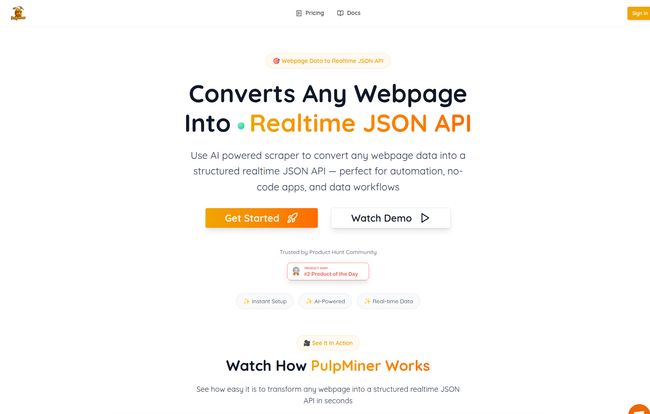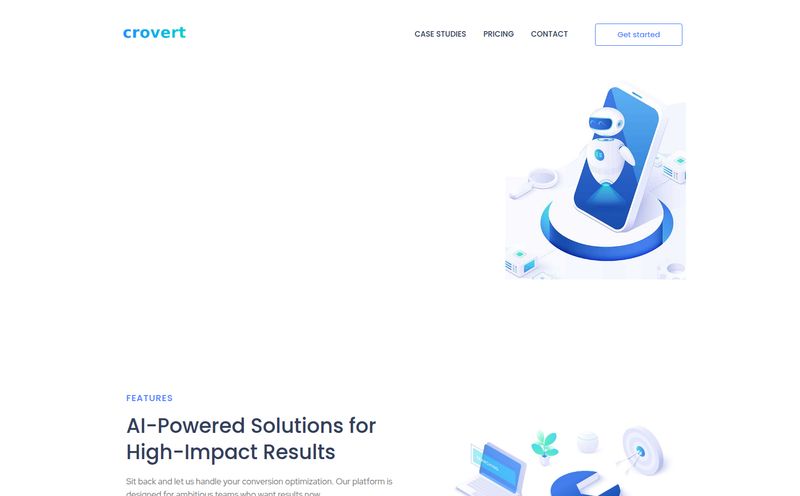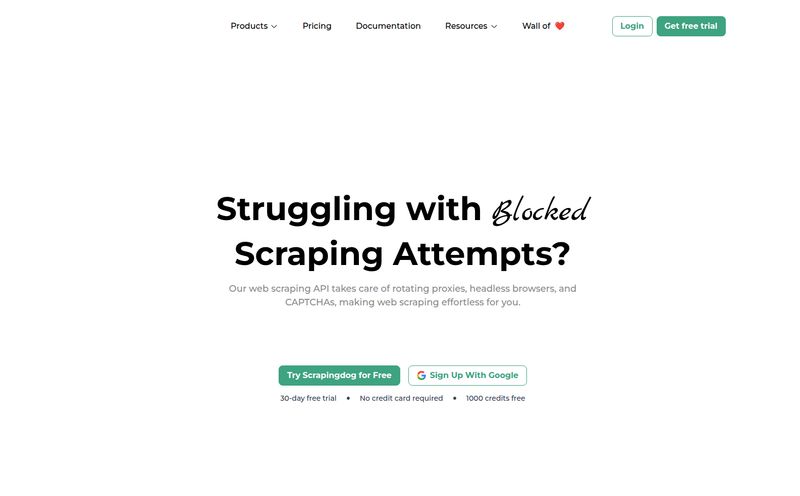If you've been in the SEO, marketing, or dev world for more than a week, you've felt the pain. The mind-numbing, soul-crushing pain of web scraping. You find the perfect data source—a competitor's pricing, a real estate listing site, a job board—and you just need to get that data into a clean, usable format. What follows is usually a descent into madness involving janky Python scripts, broken selectors, and the ever-present threat of getting your IP blocked. It’s a full-time job in itself.
I’ve spent more nights than I care to admit wrestling with scraping infrastructure. It’s a nightmare. So, when I stumbled upon a tool that claims to turn any webpage into a clean, realtime JSON API in seconds… well, my cynical SEO heart was skeptical. But intrigued. That tool is PulpMiner, and I've been kicking its tires to see if it lives up to the hype.

Visit PulpMiner
So What is PulpMiner, Really?
Think of PulpMiner as a universal translator for the web. You show it a messy, chaotic webpage filled with HTML, CSS, and JavaScript, and you tell it what information you want. Instead of you having to write the translation dictionary (the code), its AI brain figures it out for you and hands you back a perfect, structured JSON file. Instantly. Every time.
It's built for anyone who needs web data but doesn't want the technical overhead. We're talking about folks in:
- Automation & No-Code: Feeding real-time product data into a Zapier workflow or a Glide app.
- Data Analysis: Grabbing market trends or housing prices without needing a data engineering degree.
- App Development: Quickly building a prototype that relies on external data without building a whole scraping backend.
The Old Way of Scraping vs. The PulpMiner Way
To really get why this matters, you have to appreciate the 'before' picture. Before, you were spending hours inspecting HTML elements, writing custom code to target those elements, and then building an API to serve that data. And the moment that website changed its layout? Poof. Your scraper breaks. Your data feed dies. Your afternoon is ruined.
PulpMiner just... sidesteps all of that. Their whole pitch is saying goodbye to those problems. Instead of manual data extraction, you just point it at the data. Instead of wrestling with JSON structuring, its AI suggests a format. Instead of managing servers and proxies, you get one simple API call. It's a fundamentally different approach.
It boils down to a three-step dance that's almost offensively simple:
- Enter a URL: You paste the webpage you want data from.
- Generate JSON: You tell it what you want (or let the AI suggest it), and it extracts and structures the data.
- Use Your API: It gives you a secure API endpoint. You make a simple GET request, and boom, there's your data.
My Favorite Features (And Why They Matter)
Look, a slick landing page is one thing, but the devil is always in the details. After playing around with it, a few things really stood out to me as being thoughtfully designed by people who get the data struggle.
The Interactive JSON Editor is a Game-Changer
This isn’t some black box where you pray the AI gets it right. PulpMiner gives you a 'Smart JSON Editor'. Once the AI takes its first pass at structuring the data, you can go in and tweak it. You can review and customize the structure before you even think about saving the API. It’s an expandable, collapsible tree view that makes it easy to see what you're getting. This little touch gives you the control of manual scraping with the speed of AI automation. It’s brilliant.
Pay-As-You-Go Pricing That Doesn't Punish You
Can we all admit we have subscription fatigue? I feel like every SaaS tool wants a monthly commitment. PulpMiner's pricing model is, frankly, a breath of fresh air. It's a credit-based, pay-as-you-go system. You buy a block of credits, and they never expire. No monthly bills. No "use it or lose it" pressure. If you have a small project one month and a huge one the next, the model just works. This is incredibly friendly for freelancers, startups, or anyone with fluctuating data needs.
It’s Built on a Rock-Solid Foundation
When your application or workflow depends on an API, reliability is everything. It was a huge green flag for me to see that PulpMiner is powered by Cloudflare's infrastructure. They promise 99.99% uptime, have a global CDN with 275+ cities, automatic failover, and DDoS protection. This isn't some hobby project running on a single server; it's enterprise-grade stuff. It means your API will be fast, and it will be there when you need it.
Who Is This Tool Actually For?
I can see a few groups getting a ton of value out of this. If you’re a no-code maker, this is your new best friend for piping live data into your projects. If you’re a marketer or SEO, you can track competitor prices, monitor product launches, or aggregate news mentions without begging your dev team for help. And if you're a developer, this is a massive shortcut for prototyping or for any project where building and maintaining a custom scraper is just overkill.
The use cases are pretty broad. Think about it:
- E-commerce Price Tracking: Set up an API to watch prices on Amazon, eBay, and other marketplaces in real-time.
- Market Research: Aggregate job listings from multiple boards into a single feed.
- Content Aggregation: Pull articles from your favorite tech blogs into one place.
- Real Estate Insights: Monitor property listings and availability in a specific area.
Anything you can see on a webpage, you can pretty much turn into a structured data feed.
Let's Talk Turkey: The Pricing Model
As I mentioned, I’m a big fan of the pay-as-you-go model. It feels honest. The starting point is the "Hobby" plan, which gets you 600 credits for a one-time payment of $18.00. That works out to $0.03 per credit.
So what does a credit get you? They've broken it down transparently:
| Action | Credit Cost |
|---|---|
| JSON Generation | 0.25 credits per generation |
| API Request (Standard) | 0.4 credits per request |
| API Request (with JS Render) | 0.50 credits per request |
This means with your initial $18 purchase, you could make 1,500 standard API calls, or 1,200 calls to more complex JavaScript-heavy sites. I appreciate this granularity. It's not a one-size-fits-all price. For those with bigger appetites, there are Starter, Growth, Pro, and Enterprise plans with more credits and dedicated support.
Are There Any Downsides?
No tool is perfect, and it's only fair to point out the potential hiccups. First, because it's a credit system, high-volume users might find themselves calculating costs more often than with a flat-rate plan. It's a trade-off for the flexibility. Second, while the AI is very good, if you have an incredibly complex or weirdly structured website, you might need to spend a little extra time in that JSON editor to get the structure exactly right. There's a slight learning curve there, but it's leagues easier than learning a scraping library from scratch.
Frequently Asked Questions About PulpMiner
Is PulpMiner free to try?
- It's not free, but it operates on a pay-as-you-go model. The entry-level plan is a one-time $18 purchase for credits, so there's no ongoing subscription required to get started.
Do my PulpMiner credits ever expire?
- Nope! This is one of its best features. Your credits are yours until you use them, whether that's next week or next year.
Do I need to be a programmer to use PulpMiner?
- Not at all. The entire platform is designed to be no-code friendly. If you understand the basic concept of what you want to extract, you can use the interface to generate your API. Having a basic understanding of what JSON is will help, though.
How does it handle modern, dynamic websites?
- PulpMiner includes JavaScript rendering. This means it can handle sites built with frameworks like React, Vue, or Angular that load content dynamically. These API calls cost slightly more credits, but it's a crucial feature for the modern web.
How secure is the data access?
- It's quite secure. Every API endpoint you create is protected and accessible only with a unique personal API key. Plus, the entire infrastructure is backed by Cloudflare's security features.
What if I need to pull a massive amount of data?
- For very high-volume needs, PulpMiner offers an Enterprise plan. This includes things like custom pricing for bulk credits, low-latency inference, and dedicated support with SLAs.
The Final Verdict on PulpMiner
So, is PulpMiner the magic bullet for all web data problems? Look, for the vast majority of use cases that professionals like us face every day, it comes incredibly close. It successfully removes the biggest, most annoying barriers to entry for web data extraction: the coding, the maintenance, and the infrastructure.
The combination of a powerful AI engine, a user-friendly editor, and a pricing model that respects its customers is a winning formula in my book. It's not just a tool; it's a massive time-saver and headache-reducer. If you've ever found yourself staring at a webpage wishing you could just have the data in a spreadsheet, you owe it to yourself to give PulpMiner a look. It might just be the solution you've been waiting for.



